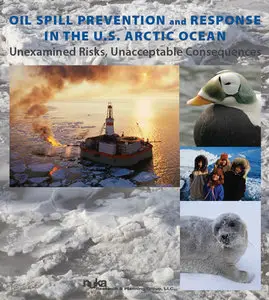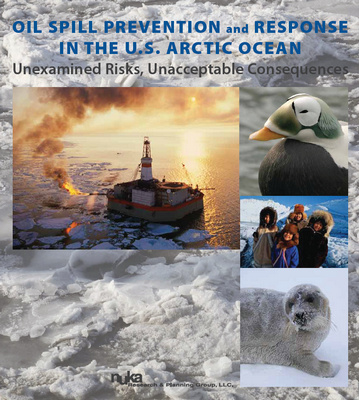Oil Spill Prevention and Response in the U.S. Arctic Ocean: Unexamined Risks, Unacceptable Consequences
PEW, Nuka | Nov. 2010 | ISBN: n/a | 146 pages | PDF | 8 MB
PEW, Nuka | Nov. 2010 | ISBN: n/a | 146 pages | PDF | 8 MB
This report examine the risks, challenges and potential consequences of oil spills associated with oil and gas exploration and production in the outer continental shelf (OCS) of the United States Arctic Ocean.
CONTENTS
Executive Summary
Chapter 1: Introduction
1.1 Purpose and Scope
1.2 Background
1.3 Key Concepts
1.3.1 The Arctic Ocean Is Different From Other Areas of the U.S. OCS
1.3.2 Government and Industry Oil Spill Plans Underestimate Blowout Risks
1.3.3 An Oil Spill Could Devastate the Arctic Ecosystem
1.3.4 Oil Spill Response Systems Are Unproved in the Arctic Ocean
1.3.5 An Oil Spill Response Gap Exists
1.4 Policy Recommendations
Chapter 2: The U.S. Arctic Ocean
2.1 Characteristics of the Arctic OCS Environment
2.1.1 Climate
2.1.2 Sea Ice
2.2 Transportation Infrastructure
Chapter 3: Oil Exploration, Infrastructure and Production Operations and Spill Risks in the Arctic Ocean
3.1 Historical Perspective on Oil and Gas in the Arctic Ocean
3.1.1 Worldwide
3.1.2 United States Arctic Ocean
3.2 Oil Exploration and Production Operations
3.2.1 Exploratory Drilling
3.2.2 Oil Production
3.3 Challenges to Oil Exploration and Production in the Arctic Ocean
3.3.1 Seasonal Ice
3.3.2 Extreme Storms
3.3.3 Infrastructure and Logistics
3.4 Potential for Blowouts and Oil Spills from Exploration and Production in the U.S. Arctic Ocean
3.4.1 Well Blowouts
3.4.2 Other Spills from Oil Production Operations
Chapter 4: Impact of Oil Spills on Arctic Environment and Ecology
4.1 Fate and Behavior of Oil Spilled in Arctic Waters
4.1.1 Weathering and Emulsification
4.1.2 Oil-Ice Interactions
4.1.3 Predicting the Fate of Oil in Sea Ice
4.1.4 Long-Term Fate of Oil Spilled in Cold-Water Environments
4.2 Vulnerabilities of the Arctic Ecosystem to Oil Spill Impacts
4.2.1 Oil Toxicity
4.2.2 Persistence of Oil Spilled in the Arctic
4.3 Impact of Oil Spills on the Arctic Environment, Ecology and People
4.3.1 Lower Trophic Level Species
4.3.2 Fish
4.3.3 Marine Mammals
4.3.4 Birds
4.3.5 People
Chapter 5: Limitations of Existing Oil Spill Response Technologies in the U.S. Arctic Ocean
5.1 Arctic Ocean Challenges
5.2 Stopping a Subsea Well Blowout
5.2.1 Subsea Well Containment and Control
5.2.2 Relief Wells
5.2.3 Challenges to Well Control in the U.S. Arctic Ocean
5.3 Applying Oil Spill Cleanup Methods in the Arctic Ocean
5.3.1 Spill Tracking, Surveillance and Modeling
5.3.2 Mechanical Recovery Methods
5.3.3 In-Situ Burning
5.3.4 Dispersants
5.4 Research and Development to Improve Oil Spill Response in Arctic Waters
5.4.1 Joint Industry Program on Oil Spill Response for Arctic Waters
5.4.2 Field Exercises and Oil Spill Drills in the U.S. Arctic Ocean
Chapter 6: Gaps in Oil Spill Prevention Planning, Response Capacity and Oversight in the U.S. Arctic Ocean
6.1 Arctic Oil Spill Response Gap
6.1.1 Response Limit Estimates for U.S. Arctic Ocean
6.2 Gaps in Oil Spill Response Planning for the U.S. Arctic Ocean
6.2.1 Oil Spill Contingency Planning for Chukchi Sea Leases
6.2.2 Planning Assumptions in Shell’s Chukchi Sea Oil Spill Contingency Plan
6.2.3 Gaps in Response Capacity for Subsea Well Blowout in the Chukchi Sea
6.2.4 Gaps in Planning and Response Capacity in the Beaufort Sea
Chapter 7: Recommendations
7.1 Improve Arctic Oil Spill Science, Monitoring and Assessment
7.1.1 Close the Knowledge Gaps Regarding Arctic Oil Spill Impacts
7.1.2 Improve Spatial Data on Environmental Sensitivities
7.1.3 Develop Arctic Oil Spill Trajectory Models
7.1.4 Consider Cumulative Impacts of Oil Exploration and Production in Arctic OCS
7.2 Assess and Plan for Worst-Case Blowout Risks
7.2.1 Conduct Risk Assessment
7.2.2 Require More Realistic Worst-Case Blowout Scenarios
7.2.3 Improve Oil Spill Prevention Technologies for Arctic Exploration and Production
7.3 Improve Arctic OCS Oil Spill Response Capacity
7.3.1 Assess Existing Oil Spill Response Capacity for Oil Spills in Arctic OCS
7.3.2 Require Operators to Demonstrate Oil Spill Response Capabilities During Agency-Led
Field Exercises
7.3.3 Improve On-Water Oil Spill Response Systems and Techniques for Arctic OCS Conditions
7.4 Conduct an Arctic OCS Oil Spill Response Gap Analysis
References
Appendixes
Appendix A: Acronyms and Abbreviations
Appendix B: Glossary
with TOC BookMarkLinks



